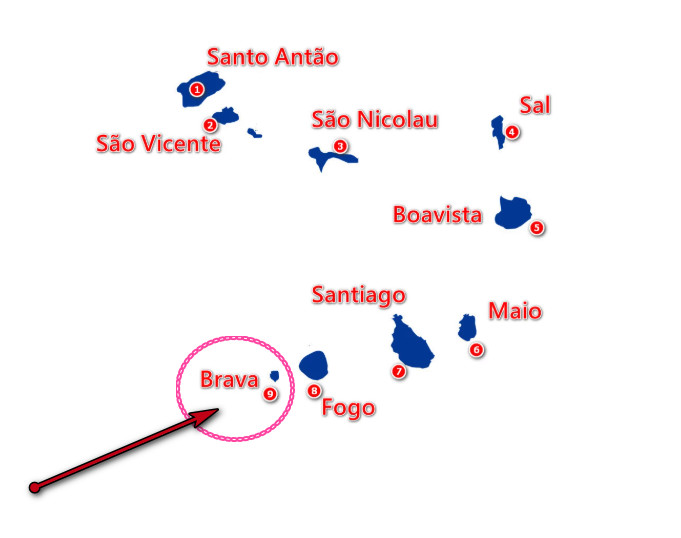Cabo Verde Brava island getting there and highlights
Brava: The Island of Flowers and Tranquility
Brava, the smallest inhabited island in the Cabo Verde archipelago, is a serene escape celebrated as the "Island of Flowers" or "Little Flower". With an area of roughly 64–67 km² and a population of 6,000–7,000, it offers lush greenery, authentic village life, and a peaceful rhythm far from mass tourism. Think of it as a treasured antique locket—compact, intricate, and rewarding for those willing to seek it out. Its name, meaning "wild" in Portuguese, hints at the rugged volcanic terrain wrapped in mist and blooms.
Location and Volcanic Origins
Brava lies in the southwest of the Sotavento (Leeward) group, just 20 km west of Fogo, to which it is geologically linked beneath the ocean. Nearby uninhabited islets include Grande, Rombo, Baixo, de Cima, Rei Luís Carneiro, Sapado, and Areia.
A young stratovolcano, Brava features 15 craters along its crest and a large central caldera formed around 400,000 years ago. The capital, Vila Nova Sintra, sits in the Fundo Grande depression—a half-buried crater. Though dormant for the last 10,000 years, small earthquakes signal ongoing activity. The island's highest point, Monte Fontainhas (976 m), dominates a rugged interior of deep valleys, steep ridges, and coastal cliffs.
The Green Oasis: Climate and Flora
Brava is the greenest island in Cabo Verde, thanks to its microclimate in Fogo's lee. Trade winds create frequent mist and fog, especially around Monte Fontainhas, feeding springs and sustaining lush vegetation. Rainfall is highest August–September, making October–February the peak blooming season—a true "green oasis."
Inland temperatures average 16°C in winter, 20°C in summer; coastal areas are warmer and drier. The landscape bursts with hibiscus, jasmine, eucalyptus, pine, dragon trees (Dracaena draco), and fruit trees like mango, papaya, and guava. Dense fog often cloaks the plateaus, enhancing the mystical, flower-scented atmosphere.

Villages and Highlights
Vila Nova Sintra
The charming capital perches high amid mountains, often called Cabo Verde's most beautiful village. Cobbled streets, colorful colonial houses, and flower-lined paths create an open-air garden. It's the cultural heart, birthplace of poet Eugénio Tavares and cradle of morna music.
Fajã d'Água
Nestled in a verdant valley, this coastal gem boasts a stunning bay—once an anchorage for whaling ships—and crystal-clear natural pools formed by volcanic rock. Fruit trees abound; it's ideal for nature walks and safe swimming.
Furna
The main fishing village and port sits in a crescent-shaped bay—an ancient volcanic crater offering natural shelter. Watch colorful boats and daily life unfold.
Other Highlights
- Nossa Senhora do Monte: A highland village for mountain hikers.
- Cachaço: Known for handmade Queijo do Cachaço goat cheese.
- Porteto Bay: Brava's only black sand beach and natural pool, near the defunct Esperadinha Airport.
- Viewpoints: MiraGrandeza, MiraGloriosa, MiraGraciosa, MiraBeleza—panoramas of valleys, sea, and Fogo.
- Fonte do Vinagre: Acidic springs with rumored medicinal properties.
Hiking and Outdoor Adventures
Brava is a hiker's paradise—short distances, big elevation gains, and trails through flower fields, acacia forests, and cloud-shrouded ridges.
Top trails:
- Eugénio Tavares Trail: Cultural and scenic.
- Trilho do Mato to Pico das Fontainhas: Summit views.
- Trilho do Mato Grande to Chão de Aguada Cachaço.
- Furna to Vinagre.
- Brava Plateaus (10 km, 3–4 hrs): From Nova Sintra, with fields and forests.
- Cova Joana: Birdwatching and ocean vistas.
- Descent to Fajã d'Água or Mosteiros.
Tip: Paths can be steep and unmarked—hire a local guide in Nova Sintra.
Other activities:
- Boat trips: Explore cliffs and coves.
- Volcanic exploration: Visit Fundo Grande crater (with guide—risky terrain).
- Botany & photography: Endemic plants, dragon trees, vibrant blooms.
Getting to Brava
Brava has no airport due to strong crosswinds; the old Esperadinha runway lies abandoned. Access is ferry-only from Fogo (São Filipe), taking 30–120 minutes. Part of the Sotavento Line (Maio–Santiago–Fogo–Brava), ferries run ~2x weekly via CV Interilhas.
Arrival: Furna port. Schedules vary—confirm in advance. Bad weather cancels sailings; allow +1 buffer day, especially for returns.
Getting Around the Island
- Aluguers (shared vans): From Furna to Nova Sintra (3 km uphill) and other villages.
- Taxis: Available; no car rentals.
- Walking: Best for trails and short hops.
Where to Stay
Accommodation is limited, authentic, and mostly in/near Nova Sintra—no large resorts.
- Djabraba's Eco-Lodge (Cruz Grande): Sustainable, 1930s-style, low-impact.
- Kaza di Zaza (Fajã d'Água): Bayfront apartments.
- Hotel Pousada Nova Sintra, Fajã d'Água Residential, Casa Eugénio Tavares: Charming guesthouses.
Best Time to Visit
- November–June (dry season): Ideal for hiking, sunny, moderate temps.
- August–September (rainy): Greenest, but wetter trails.
- October–February: Peak blooms, cool and lush.
7 day weather forecast for Brava island
Practical Tips
- Duration: 1 day for highlights; 3+ days for hikers.
- Decarbonization: Brava aims to be carbon-neutral by 2040—expect eco-focus.
- Bring: Sturdy shoes, rain jacket, cash (few ATMs), patience for ferry schedules.
Brava is for slow travelers—those who hike through clouds, sip coffee overlooking valleys, and let morna melodies linger. It's not about luxury; it's about depth, scent, and silence. Come ready to walk, breathe, and fall quietly in love.
